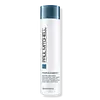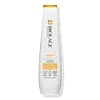What's inside
What's inside
 Benefits
Benefits

 Concerns
Concerns

 Ingredients Side-by-side
Ingredients Side-by-side

Water
Skin ConditioningSodium Laureth Sulfate
CleansingCocamide Mipa
EmulsifyingCocamidopropyl Betaine
CleansingHedychium Coronarium Flower/Leaf/Stem Extract
Skin ConditioningSimmondsia Chinensis Leaf Extract
HumectantAloe Barbadensis Leaf Extract
EmollientAnthemis Nobilis Flower Extract
MaskingRosmarinus Officinalis Leaf Extract
AntimicrobialAlgae Extract
EmollientBisamino PEG/PPG-41/3 Aminoethyl Pg-Propyl Dimethicone
PEG-12 Dimethicone
Skin ConditioningGlycol Stearate
EmollientPEG-14m
Emulsion StabilisingTetrasodium EDTA
Citric Acid
BufferingSodium Chloride
MaskingGlycerin
HumectantMethylchloroisothiazolinone
PreservativeMethylisothiazolinone
PreservativeMagnesium Chloride
Magnesium Nitrate
Parfum
MaskingBenzyl Alcohol
PerfumingBenzyl Benzoate
AntimicrobialWater, Sodium Laureth Sulfate, Cocamide Mipa, Cocamidopropyl Betaine, Hedychium Coronarium Flower/Leaf/Stem Extract, Simmondsia Chinensis Leaf Extract, Aloe Barbadensis Leaf Extract, Anthemis Nobilis Flower Extract, Rosmarinus Officinalis Leaf Extract, Algae Extract, Bisamino PEG/PPG-41/3 Aminoethyl Pg-Propyl Dimethicone, PEG-12 Dimethicone, Glycol Stearate, PEG-14m, Tetrasodium EDTA, Citric Acid, Sodium Chloride, Glycerin, Methylchloroisothiazolinone, Methylisothiazolinone, Magnesium Chloride, Magnesium Nitrate, Parfum, Benzyl Alcohol, Benzyl Benzoate
Water
Skin ConditioningSodium Laureth Sulfate
CleansingCoco-Betaine
CleansingGlycerin
HumectantSodium Chloride
MaskingAmodimethicone
Cocamide Mipa
EmulsifyingLaureth-5 Carboxylic Acid
CleansingPolyquaternium-10
PPG-5-Ceteth-20
EmulsifyingParfum
MaskingSodium Benzoate
MaskingPEG-55 Propylene Glycol Oleate
PEG-60 Hydrogenated Castor Oil
EmulsifyingSalicylic Acid
MaskingPropylene Glycol
HumectantCamellia Kissi Seed Oil
EmollientLimonene
PerfumingHexyl Cinnamal
PerfumingCoumarin
PerfumingLinalool
PerfumingButylphenyl Methylpropional
PerfumingMethyl Cocoate
EmollientBenzyl Alcohol
PerfumingHydroxycitronellal
PerfumingAmyl Cinnamal
PerfumingSodium Cocoate
CleansingSodium Hydroxide
BufferingCitric Acid
BufferingWater, Sodium Laureth Sulfate, Coco-Betaine, Glycerin, Sodium Chloride, Amodimethicone, Cocamide Mipa, Laureth-5 Carboxylic Acid, Polyquaternium-10, PPG-5-Ceteth-20, Parfum, Sodium Benzoate, PEG-55 Propylene Glycol Oleate, PEG-60 Hydrogenated Castor Oil, Salicylic Acid, Propylene Glycol, Camellia Kissi Seed Oil, Limonene, Hexyl Cinnamal, Coumarin, Linalool, Butylphenyl Methylpropional, Methyl Cocoate, Benzyl Alcohol, Hydroxycitronellal, Amyl Cinnamal, Sodium Cocoate, Sodium Hydroxide, Citric Acid
 Reviews
Reviews

Ingredients Explained
These ingredients are found in both products.
Ingredients higher up in an ingredient list are typically present in a larger amount.
Benzyl Alcohol is most commonly used as a preservative. It also has a subtle, sweet smell. Small amounts of Benzyl Alcohol is not irritating and safe to use in skincare products. Most Benzyl Alcohol is derived from fruits such as apricots.
Benzyl Alcohol has both antibacterial and antioxidant properties. These properties help lengthen the shelf life of products. Benzyl Alcohol is a solvent and helps dissolve other ingredients. It can also improve the texture and spreadability.
Alcohol comes in many different forms. Different types of alcohol will have different effects on skin. This ingredient is an astringent alcohol.
Using high concentrations of these alcohols are drying on the skin. They may strip away your skin's natural oils and even damage your skin barrier. Astringent alcohols may also irritate skin.
Other types of astringent alcohols include:
According to the National Rosacea Society based in the US, you should be mindful of products with these alcohols in the top half of ingredients.
Any type of sanitizing product will have high amounts of alcohol to help kill bacteria and viruses.
Learn more about Benzyl AlcoholCitric Acid is an alpha hydroxy acid (AHA) naturally found in citrus fruits like oranges, lemons, and limes.
Like other AHAs, citric acid can exfoliate skin by breaking down the bonds that hold dead skin cells together. This helps reveal smoother and brighter skin underneath.
However, this exfoliating effect only happens at high concentrations (20%) which can be hard to find in cosmetic products.
Due to this, citric acid is usually included in small amounts as a pH adjuster. This helps keep products slightly more acidic and compatible with skin's natural pH.
In skincare formulas, citric acid can:
While it can provide some skin benefits, research shows lactic acid and glycolic acid are generally more effective and less irritating exfoliants.
Most citric acid used in skincare today is made by fermenting sugars (usually from molasses). This synthetic version is identical to the natural citrus form but easier to stabilize and use in formulations.
Read more about some other popular AHA's here:
Learn more about Citric AcidWe don't have a description for Cocamide Mipa yet.
Glycerin is already naturally found in your skin. It helps moisturize and protect your skin.
A study from 2016 found glycerin to be more effective as a humectant than AHAs and hyaluronic acid.
As a humectant, it helps the skin stay hydrated by pulling moisture to your skin. The low molecular weight of glycerin allows it to pull moisture into the deeper layers of your skin.
Hydrated skin improves your skin barrier; Your skin barrier helps protect against irritants and bacteria.
Glycerin has also been found to have antimicrobial and antiviral properties. Due to these properties, glycerin is often used in wound and burn treatments.
In cosmetics, glycerin is usually derived from plants such as soybean or palm. However, it can also be sourced from animals, such as tallow or animal fat.
This ingredient is organic, colorless, odorless, and non-toxic.
Glycerin is the name for this ingredient in American English. British English uses Glycerol/Glycerine.
Learn more about GlycerinParfum is a catch-all term for an ingredient or more that is used to give a scent to products.
Also called "fragrance", this ingredient can be a blend of hundreds of chemicals or plant oils. This means every product with "fragrance" or "parfum" in the ingredients list is a different mixture.
For instance, Habanolide is a proprietary trade name for a specific aroma chemical. When used as a fragrance ingredient in cosmetics, most aroma chemicals fall under the broad labeling category of “FRAGRANCE” or “PARFUM” according to EU and US regulations.
The term 'parfum' or 'fragrance' is not regulated in many countries. In many cases, it is up to the brand to define this term.
For instance, many brands choose to label themselves as "fragrance-free" because they are not using synthetic fragrances. However, their products may still contain ingredients such as essential oils that are considered a fragrance by INCI standards.
One example is Calendula flower extract. Calendula is an essential oil that still imparts a scent or 'fragrance'.
Depending on the blend, the ingredients in the mixture can cause allergies and sensitivities on the skin. Some ingredients that are known EU allergens include linalool and citronellol.
Parfum can also be used to mask or cover an unpleasant scent.
The bottom line is: not all fragrances/parfum/ingredients are created equally. If you are worried about fragrances, we recommend taking a closer look at an ingredient. And of course, we always recommend speaking with a professional.
Learn more about ParfumChances are, you eat sodium chloride every day. Sodium Chloride is also known as table salt.
This ingredient has many purposes in skincare: thickener, emulsifier, and exfoliator.
You'll most likely find this ingredient in cleansers where it is used to create a gel-like texture. As an emulsifier, it also prevents ingredients from separating.
There is much debate on whether this ingredient is comedogenic. The short answer - comedogenic ratings don't tell the whole story. Learn more about comegodenic ratings here.
The concensus about this ingredient causing acne seems to be divided. Research is needed to understand if this ingredient does cause acne.
Scrubs may use salt as the primary exfoliating ingredient.
Learn more about Sodium ChlorideSodium Laureth Sulfate (SLES) is a foaming, cleansing, and emulsifying ingredient. It is created from palm kernel oil or coconut oil. SLES is not the same as sodium lauryl sulfate. It is much milder and less likely to irritate.
SLES helps create foam in personal products. It also prevents ingredients from separating, helping to elongate the shelf life.
Sodium Laureth Sulfate is a type of sulfate. It can be drying. We recommend speaking with a professional about using this ingredient if you have concerns.
Learn more about Sodium Laureth SulfateWater. It's the most common cosmetic ingredient of all. You'll usually see it at the top of ingredient lists, meaning that it makes up the largest part of the product.
So why is it so popular? Water most often acts as a solvent - this means that it helps dissolve other ingredients into the formulation.
You'll also recognize water as that liquid we all need to stay alive. If you see this, drink a glass of water. Stay hydrated!
Learn more about Water